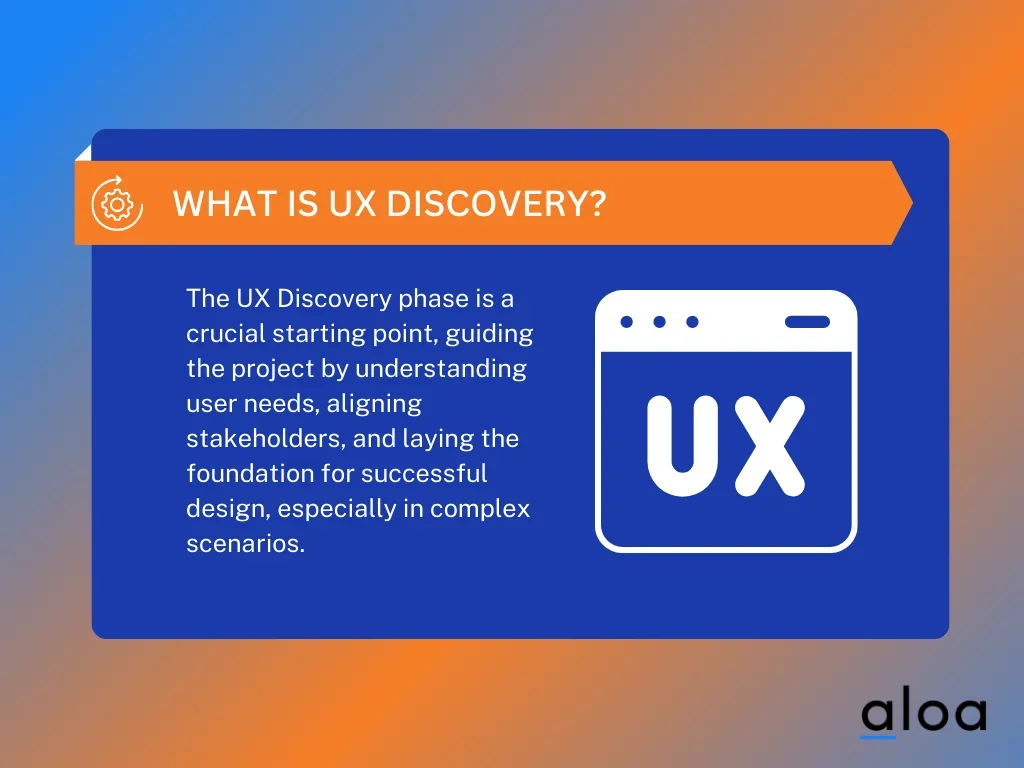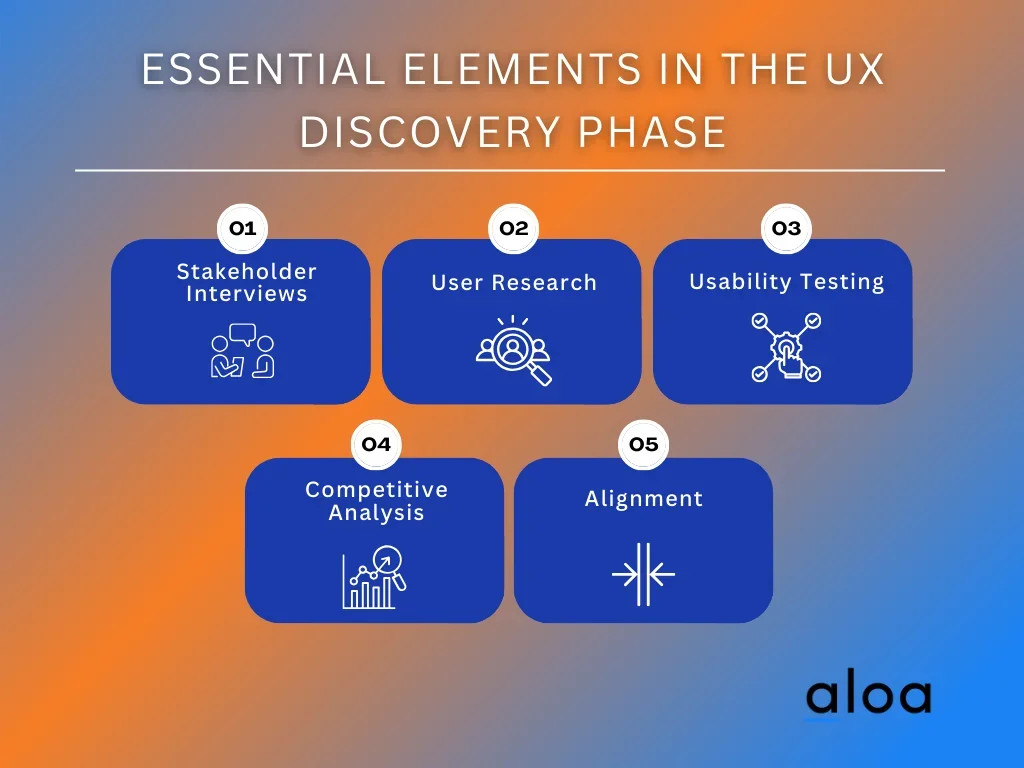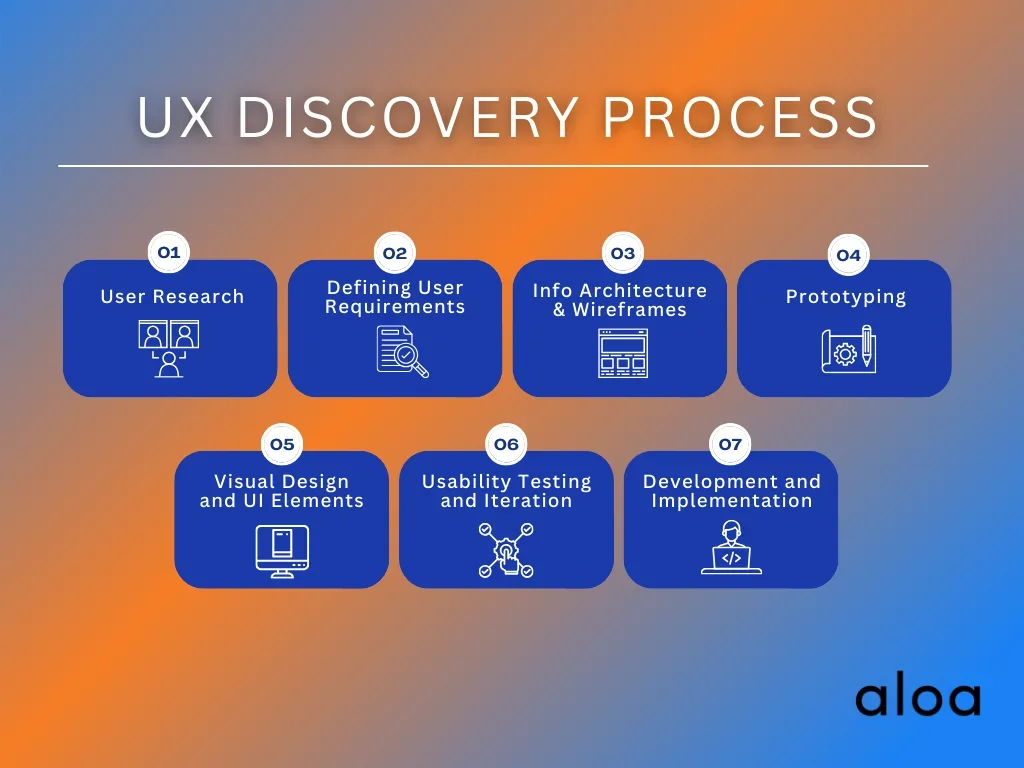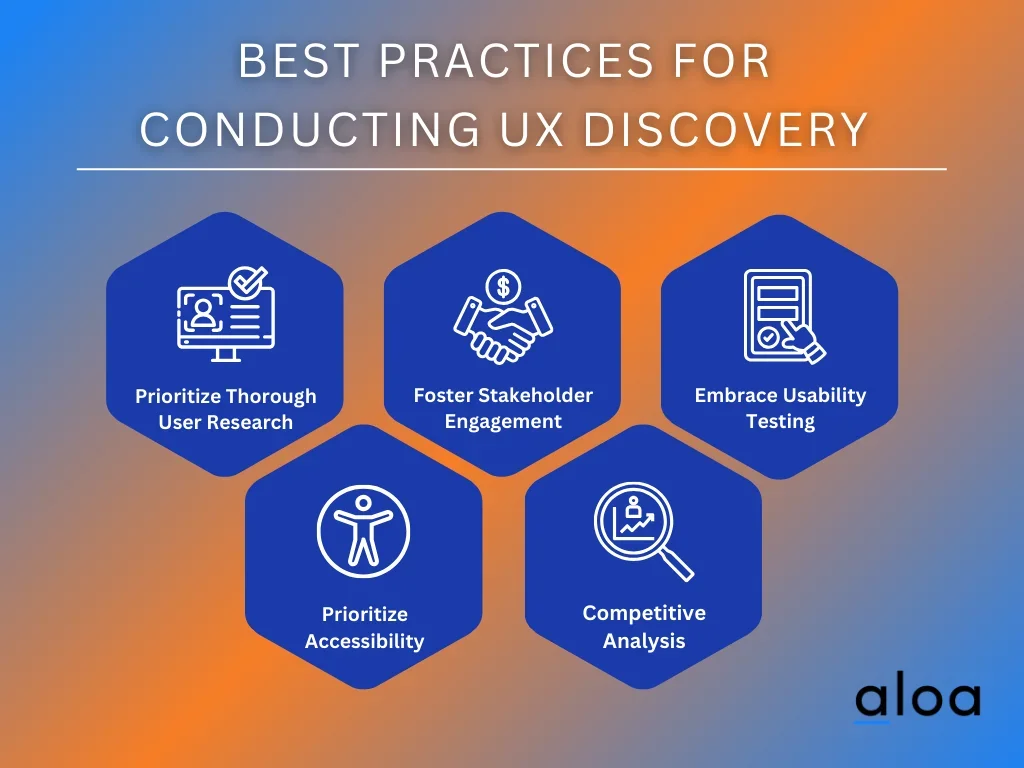The UX discovery phase holds immense significance in the realm of product design. It serves as a pivotal stage where the user-centered design takes center stage, prioritizing the needs and preferences of the users. Neglecting UX discovery can result in costly errors and missed opportunities. This crucial phase uncovers insights into user behavior and pain points. The significance of UX discovery lies in its ability to identify the problem space, align the team with a shared vision, and ensure that the final product genuinely addresses users' needs.
Aloa ensures that their projects are user-centric by employing various research methods. These methods include user research, diary studies, and focus groups. Their dedicated UX researchers collaborate closely with design teams and project managers to align the process with business goals and stakeholders' needs.
By the end of this blog, you will gain a comprehensive understanding of the UX discovery phase. Let us embark on this journey to unlock the potential of UX exploration and utilize it to create products that meet and exceed user expectations. So let's get started!
What Is UX Discovery?

The UX discovery phase is the starting point of the product design process. It serves as a guiding compass throughout the entire project, allowing teams to delve into understanding user needs, preferences, and pain points. The foundation for creating user-centered and intuitive designs is laid during this essential phase.
Moreover, it plays a crucial role in bringing stakeholders and team members together. It ensures that all individuals involved in the project, including designers and project managers, are on the same page. To improve the readability of the sentence, it can be divided into two shorter sentences.
Through extensive discovery research, the team thoroughly understands the project's goals and determines the necessary research methods. Ultimately, it serves as a pivotal starting point that lays the foundation for a successful project, especially in complex scenarios like mergers or entirely new endeavors.
Essential Elements in the UX Discovery Phase
The UX discovery phase is a crucial foundation for developing user-centric and successful products. It encompasses essential components that not only guide the design process but also ensure alignment with user needs and business objectives.

Stakeholder Interviews
Engaging in stakeholder interviews is a fundamental aspect of UX discovery. Project managers, team members, and other stakeholders communicate in these interviews to gain insights into the project's goals, objectives, and expectations. This process aids in aligning the workflow with the overarching business vision while ensuring a shared comprehension among all parties involved. Utilizing stakeholder interview templates can provide structure and guidance, facilitating thorough exploration of key topics and ensuring that important insights are captured consistently across interviews.
User Research
UX discovery is built upon user research. It involves understanding the needs, behaviors, and challenges that users face. Qualitative research uncovers insights into the aspects of user experiences, while quantitative research provides statistical data that guide design decisions. Ultimately user research plays a role in developing products that truly resonate with the intended audience.
Usability Testing
Usability testing serves as the litmus test for determining the user-friendliness of a product. It involves placing prototypes or early product versions in the hands of real users, allowing for a hands-on approach. This method helps pinpoint usability issues, uncover areas that cause friction, and gather valuable feedback for further improvements. Ultimately, usability testing ensures that the final product is intuitive and effortlessly usable.
Competitive Analysis
To ensure the success of a product, obtaining a deep understanding of the competitive landscape is crucial. During the UX discovery phase, conducting a thorough competitive analysis becomes essential. This involves evaluating what competitors offer, identifying their strengths and weaknesses, and pinpointing areas where opportunities for differentiation exist. By conducting this analysis, designers can make well-informed decisions on how to make their product stand out in the market.
Alignment
In the UX discovery phase, alignment emerges as a recurring theme. It involves ensuring that every aspect of the process, from stakeholder objectives to user research findings, is in harmony with the overall project goals. This alignment serves as a guiding force, keeping the project on course and dedicated to delivering value to both users and the business.
The Role of UX Discovery in Product Development
UX discovery plays a pivotal role in product development, ensuring that products effectively meet the needs and expectations of users. Serving as the initial phase in the design process, it informs product strategy by incorporating invaluable user insights into the overall product design.

Understanding Users' Needs
In the realm of user experience (UX) discovery, thorough research is conducted to gain a deeper understanding of users' needs and preferences. This vital comprehension forms the bedrock for crafting products that deeply resonate with the intended audience.
Incorporating User Insights into Product Design
During the UX discovery phase, valuable insights are gathered, directly influencing the product's design. This information empowers designers to make well-considered decisions about features, layout, and the overall user experience. Moreover, involving active users in this process guarantees that the resulting product meets their experiences.
Iterative Improvement
By continuously collecting new insights, the product can be refined and improved iteratively. This feedback loop ensures that the product remains aligned with evolving user expectations and market trends.
Enhancing Team Collaboration
During the UX discovery phase, collaboration among team members from different disciplines is highly encouraged. Designers, developers, product managers, and other stakeholders come together to analyze research findings and convert them into practical design decisions. This collaborative approach ensures that every individual comprehends and prioritizes user-centric design principles.
Mitigating Risk in New Projects
For new projects, implementing UX discovery plays a pivotal role in mitigating the risk of developing products that fail to resonate with users. By systematically investigating user experiences, it offers a robust foundation for product development by identifying potential challenges early on. This proactive approach not only saves valuable time but also optimizes the allocation of resources.
Incorporating Quantitative Research
UX discovery incorporates both qualitative insights and quantitative research. This comprehensive approach allows for a broader range of user perspectives, yielding valuable insights into preferences and behaviors.
UX Discovery Process
The foundation for creating exceptional user experiences lies in the UX discovery process. This comprehensive guide will lead readers through each process step, providing valuable insights and strategies for every stage.

Step 1: User Research
User research forms the bedrock of the entire UX discovery process. It entails profoundly understanding your target audience, including their behaviors, needs, and preferences. Without this indispensable knowledge, crafting a product that genuinely resonates with users is akin to aiming at a target while blindfolded.
Conducting Interviews and Surveys
User interviews and surveys are essential components of user research. They serve as the foundation for direct interaction with the target audience, enabling insightful discoveries. Interviews reveal qualitative insights, while surveys provide valuable quantitative data.
Creating User Personas
User personas serve as character profiles in a novel, presenting fictional representations of typical users. These personas encompass various details like names, backgrounds, goals, and pain points. By making abstract user data more tangible, personas enable teams to empathize with specific user archetypes and design accordingly.
User journeys, however, present a visual representation of the user experience. They illustrate the sequence of user interactions with your product, from initiation to conclusion. By identifying moments of engagement, challenges encountered, and decision-making instances, user journeys provide valuable insights into how individuals interact with your product.
Step 2: Defining User Requirements
User research lays the foundation, while defining user requirements determines the path of your design. During this stage, insights gathered from users are transformed into practical design principles and functionalities. This ensures that your product aligns with the specific needs of the identified user base.
- Analyzing User Research: Dive deep into the gathered user data to uncover patterns, outliers, and trends.
- Identifying User Goals and Tasks: Understanding user goals and necessary tasks empowers intentional design.
- Defining Functional Requirements: These specify essential product features, guiding development and meeting user needs.
- Considering Technical Constraints: Ensure the design aligns with the chosen technology for smoother development.
- Prioritizing Requirements: Assess and prioritize requirements based on their impact and project constraints.
- Documenting Requirements: Detailed documents create a shared understanding and streamline the design and development process.
Step 3: Information Architecture and Wireframing
Once the user needs are thoroughly understood and the requirements have been defined, it is time to carefully structure your product's layout and functionality. To ensure a user-friendly and intuitive experience, the roles of information architecture and wireframing are pivotal.
Information Architecture
Information architecture serves as the blueprint for a building, delineating how content and features are meticulously organized and interconnected within a product. A well-structured information architecture not only enhances user navigation but also ensures that users can effortlessly find the information they seek.
Wireframing
Wireframes serve as the fundamental structure of a product, acting like a skeletal framework. They provide low-fidelity representations that concentrate solely on layout and functionality, devoid of any visual distractions. In the early stages, wireframes play a pivotal role in obtaining valuable feedback, allowing designers to refine their designs before investing in higher fidelity prototypes.
Step 4: Prototyping
Prototyping is the pivotal stage: designs evolve into a tangible reality, breathing life into your ideas. Through prototyping, you can generate interactive models that offer a hands-on experience of your product. This crucial phase bridges abstract design concepts and the user's authentic encounter with your creation.
Interactive prototypes give users a firsthand experience of the final product's functionality. By allowing users to click, interact with elements, and immerse themselves in the product's usability, these prototypes offer a sneak peek into its full potential.
Prototypes serve a purpose beyond mere display; they are designed for thorough testing. By conducting user tests during the initial stages of the design process, invaluable feedback can be obtained. Such testing helps to pinpoint usability issues, reveal unforeseen user behaviors, and validate design choices.
Step 5: Visual Design and UI Elements
Visual design enhances the aesthetics and emotional appeal of your product. This crucial step goes beyond functionality, imparting it with captivating visual allure. To create an immersive and interactive design, consider following these helpful tips:
- Choosing Color Palettes and Typography: Selecting color palettes and fonts that align with your brand enhances the visual experience.
- Layout and Composition: Effective layout and composition guide users seamlessly through their journey.
- Selecting Icons and Images: Carefully choosing visuals improves user understanding and adds user-friendliness.
- Maintaining Visual Consistency: Design consistency ensures users can anticipate how the product functions and navigates.
- Ensuring Accessibility: Prioritizing accessibility during design caters to a broader audience, including individuals with disabilities. Following guidelines is crucial.
Step 6: Usability Testing and Iteration
During usability testing and iteration, the design undergoes true evolution and improvement through fundamental user interactions and feedback. Usability testing involves the observation of real users interacting with a product. This hands-on approach helps identify usability issues and gather qualitative feedback. How users navigate, click, scroll, and interact with your product deserves careful attention. By observing their interactions, you can uncover any confusion or frustration they may encounter.
Collecting feedback directly from users about their experience is crucial to making informed design changes. The insights users provide offer valuable guidance and ensure that your design aligns with their expectations. Standing receptive to users guarantees a harmonious match between your design choices and their desires.
Step 7: Development and Implementation
The well-crafted design you have created must now undergo its final transformation into a fully functional product. The collaboration between designers and developers holds immense importance in ensuring that the envisioned outcome is faithfully achieved. To facilitate smooth development and implementation, consider these crucial steps:
- Collaborating with Developers: Designers and developers work closely, with designers contributing assets and developers transforming them into code through clear communication.
- Providing Design Assets and Documentation: Seamless development requires necessary assets like mockups, detailed style guides, and comprehensive documentation to eliminate ambiguity.
- Conducting Design Reviews: Regular design reviews with the development team address implementation challenges and maintain design consistency, ensuring alignment with the envisioned user experience.
- Testing Functionality and Interactions: Thoroughly testing the product's functionality and interactions before launch ensures it meets user requirements and provides a seamless, delightful experience.
- Gathering Post-Launch Feedback: The UX discovery process extends beyond launch, involving continuous user feedback collection and performance monitoring to adapt to changing user needs.
Best Practices for Conducting UX Discovery
Successful execution of the UX discovery phase relies heavily on a set of best practices. These guidelines ensure designers glean valuable insights, leading to user-centered, intuitive designs. Here, we delve into the best practices that propel the UX discovery process to new heights.

- Prioritize Thorough User Research: Neglecting user research can lead to misguided design decisions. Instead, invest time understanding your target audience through interviews, surveys, and behavior analysis, guiding your design choices for user-centric products.
- Foster Stakeholder Engagement: Effective stakeholder communication aligns design goals with business objectives. Keep them engaged, share findings, and seek feedback to ensure well-informed and supported design decisions.
- Embrace Usability Testing: Skipping usability testing impacts product quality. Conduct regular tests with real users to refine your product and meet their expectations.
- Prioritize Accessibility: Accessibility should never be overlooked. Incorporate guidelines and usability testing for inclusivity, ensuring your product is usable by everyone, including those with disabilities.
- Conduct Comprehensive Competitive Analysis: Overlooking competitive analysis limits your product's success. Analyze competitors to identify gaps and strengths, helping your product stand out.
Key Takeaway
User experience (UX) plays a crucial role in the development of products and determines the success of startups. It entails comprehending the needs, preferences, and challenges faced by users to establish a seamless and pleasurable interaction with your offering or service. Investing in UX from the beginning offers valuable advantages. It allows for early identification of potential issues, reduces development costs, and ensures alignment with the target audience's preferences. A well-designed UX not only enhances customer satisfaction but also boosts user retention.
Startups, mainly, can gain a competitive advantage by offering an exceptional user experience (UX). This helps them stand out in markets and impresses investors and potential partners who prioritize user-centric design when considering collaboration. To succeed in the contemporary business landscape, it is crucial to prioritize UX discovery within your projects. This entails seeking guidance from experts, conducting thorough user research, and consistently refining your design to maintain a user-centric and competitive product or service.
To gain valuable insights and expert guidance on prioritizing UX in your projects, you can contact resource[email protected]. Unlock the potential of your product development and startup journey with professional advice on enhancing user experience.

